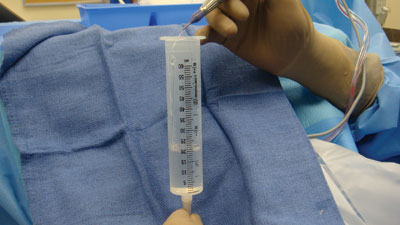Simple steps enhance phaco fluidics
Proper inflow, outflow and vacuum holding power are key.
Improving fluidics for phacoemulsification can be a simple task. A surgeon should raise the height of the hanging balanced salt solution bottle for sufficient inflow, optimize the aspiration flow rate for correct outflow, and choose the right vacuum level for holding power.
At OSN New York 2011, Uday Devgan, MD, Healio.com/Ophthalmology Section Editor, noted that the confined space of the anterior chamber measures only 0.25 cc, or approximately six to eight drops, “so there is very little fluid that we are actually working in.” Even if the posterior chamber is included, space is still tight.
The flow achieved is proportional to the tubing size and changing pressure.
“If you are using really small tubing such as with micro-coaxial phaco, you need a higher level of vacuum to achieve a relatively low flow,” Dr. Devgan said. Conversely, the larger phaco tip allows for higher flow to be achieved with lower vacuum.
Bottle height
Raising the hanging balanced salt solution bottle height is important to maintain inflow because the bottle is the only source of fluid that enters the eye. There are two sources of outflow: suction via the phaco probe and leakage from incisions.
Leakage is significant, Dr. Devgan said. Unlike retina specialists who operate within a completely sealed chamber, cataract surgeons must concern themselves with phaco burns and therefore intentionally create a slightly leaky incision.
 Measure the actual amount of fluidic inflow at a specific bottle height by filling an empty syringe using the phaco handpiece for 1 minute. Image: Devgan U
|
The key to preventing surge is to keep the fluid inflow equal to or greater than the outflow.
Dr. Devgan said he prefers to operate in a higher-flow environment for efficiency.
“I want to keep things moving,” he said. Maintaining higher inflow is accomplished by raising the bottle height as well as the outflow aspiration rate.
Aspiration flow rate
To optimize outflow, one should first measure the actual inflow of fluid.
“No one tells you how to do this, but it is quite simple,” Dr. Devgan said.
An empty 60-cc syringe that is plugged at the bottom can be used to measure fluid volume. With the bottle height at the surgeon’s typical setting and the phaco handpiece at the height of the patient’s eye, the surgeon steps on the phaco foot pedal to turn on the infusion flow for 60 seconds and measures the volume of fluid.
“This will tell you the maximum amount of fluid inflow with your current phaco tip and settings, so your outflow better be less,” Dr. Devgan said.
For a measured inflow of 55 cc/min at a high bottle height, Dr. Devgan recommended that the peristaltic pump aspiration rate be set at a maximum of 40 cc/min, to allow for roughly 10 cc/min of leakage from incisions and a safety buffer of 5 cc/min.
The aspiration flow rate can also determine the speed and followability of surgery: slow (15 cc/min), medium (30 cc/min) or fast (45 cc/min).
Vacuum level
The last step is setting the proper vacuum level. The purpose of vacuum is twofold: holding power and removing cataract fragments.
“Occlusion is required for the grip,” Dr. Devgan said. “If you want to hold on to the nucleus so you can chop it, the vacuum level has to be sufficiently high.”
Peristaltic pump systems will deliver low vacuum and high flow when the phaco tip is open, but will then switch to the higher preset vacuum level and lower flow as the tip is occluded with cataract material.
Phaco power is paramount in grooving and sculpting, while the role of fluidics is directed to aspirating the lens emulsion.
“It’s OK to have a lower inflow as we see with some of the new, smaller micro-tips, as long as you balance it with a lower outflow,” Dr. Devgan said.
For chop and quadrant removal, the goal is to hold on to cataract pieces and for the fluidics to ensure that lens fragments come to the tip. In this scenario, Dr. Devgan said he prefers a higher inflow because he wants to use a higher vacuum and aspiration flow.
“I want the pieces to come to me for both efficiency and safety,” he said.
But for irrigation and aspiration and cortex removal, the inflow can be moderate, along with a moderate aspiration flow and high vacuum.
“As we switch to smaller phaco tips, such as going from 2.8 mm to 2 mm or smaller, we need to remember that the settings such as aspiration flow rate and vacuum level will need to be matched to the lower inflow rate of the smaller tubing,” Dr. Devgan said. – by Bob Kronemyer
For more information:
- Uday Devgan, MD, can be reached at 11600 Wilshire Blvd., Suite 200, Los Angeles, CA 90025; 800-337-1969; fax: 310-388-3028; email: devgan@gmail.com.
- Disclosure: No products or companies are mentioned that would require financial disclosure.
